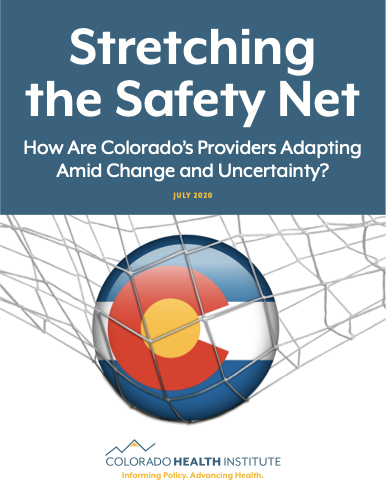
Stretching the Safety Net

These clinics — many of which were established to serve people who have faced historic and economic inequities — were weakened at a time when access to health care was vital for Coloradans dealing with the effects of a pandemic. And safety net clinics are anticipating that even more Coloradans will use their services because of lost jobs and economic struggles.
Safety net clinics of all types, many of which over the past seven years had ramped up capacity to serve newly insured people after the state expanded Medicaid in 2013 under the Affordable Care Act (ACA), recently grappled with a statewide decline in Medicaid enrollment of 11.7% from the peak. This represents a decrease of over 100,000 Coloradans between May 2017 and March 2020. The decline was due to a combination of immigration policies, economic conditions, and administrative changes on the part of Health First Colorado, the state’s Medicaid program.
The decrease in patients with Medicaid and an increase in uninsured and underinsured patients cut revenue at many clinics. Clinics responded in a variety of ways, including making budget cuts, laying off staff, and ramping up fundraising efforts.
Then came the COVID-19 pandemic. Hundreds of thousands of Coloradans have lost jobs and wages, and clinics now are planning for an anticipated surge in patients that may have long-term implications for the safety net. This is all while still ensuring that those who already lost access to coverage don’t fall through the cracks.
To understand the dynamics affecting Colorado’s safety net clinics in 2020, the Colorado Health Institute (CHI) conducted mixed-methods research. CHI interviewed a variety of stakeholders and collected annual counts of patients by coverage source from five types of safety net providers. The data focus on the impacts of changing volumes of Medicaid and uninsured patients from the perspective of safety net providers.
This report outlines the findings of that research and offers context about the current state of Colorado’s health care safety net.
The first section analyzes the factors to which clinics were responding as 2020 began and includes new data about the mix of payers at safety net clinics between 2013 and 2019. The second section describes how these factors have frayed the safety net and affected clinics’ responses to the COVID-19 pandemic.
Each section includes key findings, illustrative quotes from people involved in the safety net community, links to supplementary material, and policy questions to inform further discussion. The report concludes with a Safety Net Opportunity Matrix that highlights examples of policies and strategies that could support the resilience of Colorado’s health care safety net.
Despite the new challenges brought about by COVID-19, safety-net providers remain dedicated to meeting the needs of their patients. There are numerous opportunities to shore up the state’s safety net providers in the short and long terms. Strategies include supporting safety net operations, mitigating a backslide on oral health services, and addressing fear and disenfranchisement within immigrant communities.


